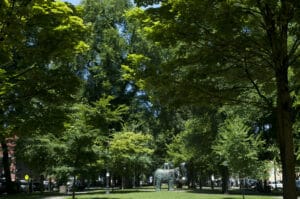Mature trees are some of the most beautiful and awe-inspiring natural features on a piece of property. Their sheer height and multitude of gnarled, curling branches never fail to capture the attention of passersby.
These trees can be fairly sensitive to changes in the environment surrounding them, so they require a high level of care. Their requirements for pruning, watering and protection from disease are different from younger trees. Improper watering and pruning could make a mature tree much more vulnerable to deadly diseases.
Perfect Pruning
To ensure the health of your gorgeous mature trees, it’s important to remove the parts that have died or become diseased. You should also have a professional arborist perform what is known as an end-weight reduction. While it’s only performed on evergreens, this involves reducing the amount of weight carried on each branch in order to prevent the branches from breaking off (and potentially hurting someone). If performed improperly, these pruning techniques could actually starve the tree by leaving too few leaves attached or damage it in some other way.
In addition to pruning the tree itself, you should remove all plants that are competing with the tree for resources. The number one pesky plant that loves to steal trees’ resources is ivy. You can do a lot for the health of your tree by pulling all the ivy off it. It’s best to get going on this early, since ivy will attach pretty firmly to a tree once it gets a foothold.
Well-Placed Watering
Mature trees need their water levels to be just right. If your area isn’t getting a decent amount of rainfall, you should give your trees a deep watering on a monthly basis. You should consult with professional arborists to find out how much water your tree needs overall.
Defense Against Disease
As a tree grows older, its ability to defend itself against pests and diseases wanes. Certain pests that can harm your tree include whiteflies, aphids, thrips and scales. Diseases to watch out for include the fungal diseases anthracnose, oak root fungus, powdery mildew, and verticillium wilt as well as the bacterial disease fire blight. If you believe that your tree has a disease, you should consult a professional arborist for advice and treatment. Removing competing plants, mushrooms and excess soil build-up from the base of the tree can help keep these blights to a minimum.
As big as they are, mature trees are fragile. It’s important to pay close attention to their health. A professional arborist can keep you in the know regarding watering, pruning and disease prevention.
With proper care, your trees may stay standing long enough to be historical relics.
